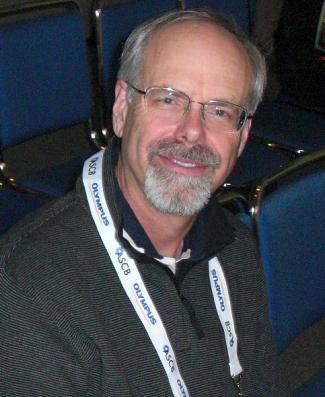 Welcome! Since 1987, Dr. Stith has been at the downtown campus...University of Colorado Denver, in the department of Integrative Biology. He teaches General Cell Biology, Developmental Biology, and Advanced Cell Biology of Disease.
Welcome! Since 1987, Dr. Stith has been at the downtown campus...University of Colorado Denver, in the department of Integrative Biology. He teaches General Cell Biology, Developmental Biology, and Advanced Cell Biology of Disease.
Undergraduate students (along with graduate students) are central to his research program. Students learn animal care, how to obtain and handle sperm and eggs, then use our In Vitro Fertilization (IVF) protocols to fertilize in Petri dishes. We currently measure many fertilization events (including lipid action, Src tyrosine kinase, phosphatase activity, and calcium release leading to gravitational rotation, calcium waves and first cleavage). Students are authors on research paper and present at national meetings. 
Dr. Stith's lab emphases studies involving tyrosine kinases (e.g., Src tyrosine kinase, which plays a role in cancer and in fertilization in the animal model system Xenopus laevis), tyrosine phosphatases, insulin action, antidiabetic glucophage (metformin), and calcium release during Xenopus fertilization. More specifically, he looks at how a lipid is produced during fertilization (the lipid is phosphatidic acid or PA), and how this lipid PA binds to and activates Src tyrosine kinase. Src then phosphorylates and activates Phospholipase C-gamma (PLCg). PLCg then breaks down the lipid called PIP2, producing IP3 which releases intracellular calcium...calcium then induces fertilization events.
Not only is PA activation of Src an important step in Xenopus fertilization, but it may reflect a new pathway to cancer. Both PA and Src activity are elevated in many cancers, so elevated PA may induce cancer through Src. Note that other work has shown that PA also activates mTOR which would lead to cancer.
Using 5 different Src inhibitors, we have also found that PA can slowly activate PLC through a pathway independent of Src. This finding is related to the many papers that show that PA (but not other lipids) bind and activate PLC from Xenopus but also in many mammalian cells. Like using a belt and suspenders, this other slower path may be a back up mechanism for fertilization.
Recently, we found that Xenopus fertilization (i.e., add sperm to eggs), addition of calcium ionophore or PA to Xenopus eggs all induce an activation and cycling of Src activity (with peaks about every five min). Our current model is that once Src is activated, it phosphorylates and activates a tyrosine phosphatase. The tyrosine phosphatase then removes the activating phosphate on Src (at tyrosine 418), and this deactivates Src. Deactivated Src allows deactivation of the tyrosine phosphatase. As one of the three agonists is still present, Src is then reactivated and this starts the next cycle. We have also shown that tyrosine phosphatase activity is elevated after Xenopus fertilization.
